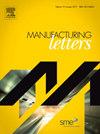Mechanical property improvements of LPBF-AlSi10Mg via forging to modify microstructure and defect characteristics
IF 2
Q3 ENGINEERING, MANUFACTURING
引用次数: 0
Abstract
Additive Manufacturing (AM) processes have versatile capabilities but are susceptible to the formation of as-cast non-equilibrium microstructures, process-induced defects, and porosity, which have deleterious effects on the mechanical performance. As part of our NSF-ERC-HAMMER program, isothermal forging was investigated as a novel post-processing technique for refining microstructure, reducing process defect severity, and thereby improving mechanical properties. Specimens of Laser Powderbed Fusion (LPBF) AlSi10Mg were fabricated over a range of process parameters and tensile tested as a baseline. Initial work focused on duplicate AM material that was then hot forged with 20 % strain to investigate the effects of isothermal forging at one temperature and strain rate on the microstructure, tensile, and fatigue properties of the as-deposited materials. The microstructures, process-induced defect populations, and tensile/fatigue properties of both as-deposited and forged materials were quantified and analysed by OM, EBSD, XCT, and SEM by various NSF-ERC-HAMMER team members. Isothermal hot forging was found to induce recrystallisation and modify process-induced defect geometry along with increasing tensile ductility. The effects of AM deposition parameters and forge post-processing conditions on LPBF AlSi10Mg will be discussed in terms of microstructure, mechanical properties, and fractography.
通过锻造改变微观结构和缺陷特征,改善 LPBF-AlSi10Mg 的机械性能
增材制造(AM)工艺具有多功能性,但容易形成铸造时的非平衡微结构、工艺引起的缺陷和孔隙率,从而对机械性能产生有害影响。作为国家自然科学基金-环境科学研究中心-HAMMER 项目的一部分,等温锻造作为一种新型后处理技术进行了研究,以完善微观结构、减少工艺缺陷的严重程度,从而改善机械性能。在一定的工艺参数范围内制作了激光粉末熔床(LPBF)AlSi10Mg 试样,并作为基线进行了拉伸测试。最初的工作重点是复制 AM 材料,然后以 20% 的应变进行热锻,以研究在一个温度和应变率下进行等温锻造对沉积材料的微观结构、拉伸和疲劳性能的影响。国家自然科学基金委员会-能源研究中心-HAMMER 小组的多名成员通过 OM、EBSD、XCT 和 SEM 对沉积材料和锻造材料的微观结构、加工过程引起的缺陷群以及拉伸/疲劳性能进行了量化和分析。研究发现,等温热锻可诱导再结晶并改变工艺引起的缺陷几何形状,同时增加拉伸延展性。我们将从微观结构、机械性能和断口形貌方面讨论 AM 沉积参数和锻造后处理条件对 LPBF AlSi10Mg 的影响。
本文章由计算机程序翻译,如有差异,请以英文原文为准。
求助全文
约1分钟内获得全文
求助全文
来源期刊

Manufacturing Letters
Engineering-Industrial and Manufacturing Engineering
CiteScore
4.20
自引率
5.10%
发文量
192
审稿时长
60 days
 求助内容:
求助内容: 应助结果提醒方式:
应助结果提醒方式:


